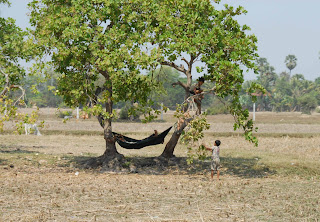.JPG)
We hired a driver to take us through Cambodia, only an 8 hour drive from North to South, passing amazing scenery along the way; monks wandering streets collecting alms for the poor, slaughtered animals being taken to local markets .JPG) and rural village life scattered in a jungle landscape along the Tonle Sap and Mekong Rivers. We drove through Phnom Penh, at the convergence on the two rivers, with no plans to stop and sightsee. Neither of us had much interest in seeing S-21 and the mass graves within the Killing Fields, the stories are chilling enough.
and rural village life scattered in a jungle landscape along the Tonle Sap and Mekong Rivers. We drove through Phnom Penh, at the convergence on the two rivers, with no plans to stop and sightsee. Neither of us had much interest in seeing S-21 and the mass graves within the Killing Fields, the stories are chilling enough.
 We arrived in Sihanoukville, a beach town along the undeveloped southern coast and found a place to stay on Serendipity Beach. The crescent shaped beach is lined with restaurants and bars and the atmosphere is extremely relaxed due to the lawlessness of the area. We found our spot on the beach with comfortable beach chairs, good music and friendly staff and spent the next 6 days not moving much. During the day, people stop by to sell just about anything; manicures, massages, jewelry, sarongs, fruits/vegetables, drinks, meats, fish, etc. You literally don’t need to move from your beach chair as the entire market comes to you. The kids are especially hard to say no to but will usually just sit down hang out once they know you aren’t going to buy anything.
We arrived in Sihanoukville, a beach town along the undeveloped southern coast and found a place to stay on Serendipity Beach. The crescent shaped beach is lined with restaurants and bars and the atmosphere is extremely relaxed due to the lawlessness of the area. We found our spot on the beach with comfortable beach chairs, good music and friendly staff and spent the next 6 days not moving much. During the day, people stop by to sell just about anything; manicures, massages, jewelry, sarongs, fruits/vegetables, drinks, meats, fish, etc. You literally don’t need to move from your beach chair as the entire market comes to you. The kids are especially hard to say no to but will usually just sit down hang out once they know you aren’t going to buy anything.
.JPG) The week went by rather fast and we were flying back to Thailand on March 14th to meet Matt’s Mom.
The week went by rather fast and we were flying back to Thailand on March 14th to meet Matt’s Mom..JPG)
.JPG) and rural village life scattered in a jungle landscape along the Tonle Sap and Mekong Rivers. We drove through Phnom Penh, at the convergence on the two rivers, with no plans to stop and sightsee. Neither of us had much interest in seeing S-21 and the mass graves within the Killing Fields, the stories are chilling enough.
and rural village life scattered in a jungle landscape along the Tonle Sap and Mekong Rivers. We drove through Phnom Penh, at the convergence on the two rivers, with no plans to stop and sightsee. Neither of us had much interest in seeing S-21 and the mass graves within the Killing Fields, the stories are chilling enough. We arrived in Sihanoukville, a beach town along the undeveloped southern coast and found a place to stay on Serendipity Beach. The crescent shaped beach is lined with restaurants and bars and the atmosphere is extremely relaxed due to the lawlessness of the area. We found our spot on the beach with comfortable beach chairs, good music and friendly staff and spent the next 6 days not moving much. During the day, people stop by to sell just about anything; manicures, massages, jewelry, sarongs, fruits/vegetables, drinks, meats, fish, etc. You literally don’t need to move from your beach chair as the entire market comes to you. The kids are especially hard to say no to but will usually just sit down hang out once they know you aren’t going to buy anything.
We arrived in Sihanoukville, a beach town along the undeveloped southern coast and found a place to stay on Serendipity Beach. The crescent shaped beach is lined with restaurants and bars and the atmosphere is extremely relaxed due to the lawlessness of the area. We found our spot on the beach with comfortable beach chairs, good music and friendly staff and spent the next 6 days not moving much. During the day, people stop by to sell just about anything; manicures, massages, jewelry, sarongs, fruits/vegetables, drinks, meats, fish, etc. You literally don’t need to move from your beach chair as the entire market comes to you. The kids are especially hard to say no to but will usually just sit down hang out once they know you aren’t going to buy anything..JPG) The week went by rather fast and we were flying back to Thailand on March 14th to meet Matt’s Mom.
The week went by rather fast and we were flying back to Thailand on March 14th to meet Matt’s Mom..JPG)













